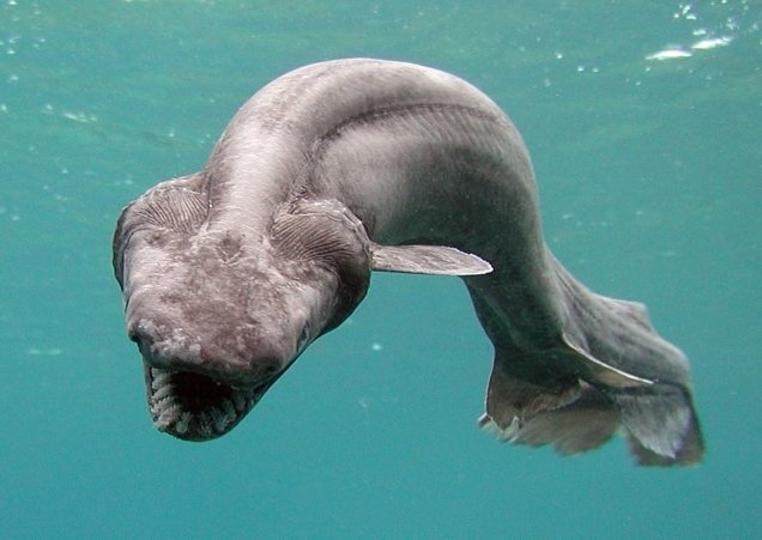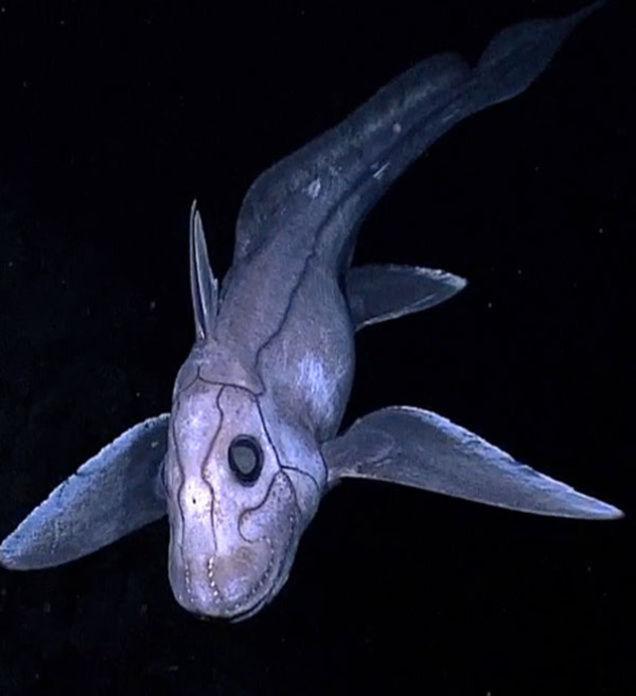10 scary deep-sea creatures

The deep sea is the place farthest from where humans live. Devilish octopuses, squids, eels, anglerfish and sharks that live in the depths of the cold, dark thousands of meters of the ocean. Doesn't it look delicious? Do you think that it is the same when you look at its appearance and ecology? (Related article: A hellish fisherman appears, tweeting only deep-sea fish like aliens!)
image: WikimediaScientific name: Goblin shark
Habitat: According to the Florida Museum of Natural History, it is found on the Mississippi River coast in Australia and can live up to a depth of about 1,300 m. It can also be found in the deep seas of Tokyo Bay, Suruga Bay, and Sagami Bay in Japan.
Ecology: This jaw, this tooth. Goblin sharks are clearly predators, but little is known about other ecosystems. "It's a little-known species. It's rarely found all over the world. Their characteristic protruding jaws are in the water column," said Christian Bird, Ph.D. in deep-sea shark ecology at the University of Southampton. This is to feed on fish and shellfish that move quickly. "
Features: This eerie deep-sea shark is known for its long blade-like snout (feces, mouth area) and nightmarish teeth. According to Shark Sider, the body is translucent, and light pink is the color of internal organs.
video: EVNautilusScientific name: Grimpoteuthis
Habitat: As the name implies, a cute octopus with ears like "Dumbo" lives at a depth of about 3,000 to 4,000 m. According to the Aquarium of the Pacific, Dumbo Octopus has been identified in many parts of the world, including waters in Australia, California, and Oregon.
Ecology: According to Oceana, it feeds on invertebrates such as krill and jellyfish on the ocean floor.
Features: It may look cute, but imagine this octopus floating in a large group. According to Dr. Nicholas Higgs, Deputy Director of the University of Plymouth Marine Research Institute, "Dumbo Octopus wraps its prey like a balloon and eats it." It's like being killed by a horde of toddlers. The Dumbo Octopus is only 20 cm high, but it's hard to believe that it's a staple food of jellyfish.
Photo: Tach_RedGold & Green / FlickrScientific name: Giant isopod (Bathynomus giganteus)
Habitat: Giant isopods are found on the coast of the Yucatan Peninsula, Mexico, at a depth of approximately 360-1,050 m.
Ecology: This little monster is a scavenger (scavenger) that grows from a total length of 4 cm to 35 cm. According to a paper published in Deep-Sea Research Part I: Oceanographic Research Papers in 2003, squids and fish remained in the body of the giant isopod.
Features: The most terrifying thing is that you can live even if you fast for up to 5 years. Females that breed pups can probably be prevented from feeding so that they are not exposed to predators, said Dr. Higgs. When the scavenger Giant Isopod approaches the carcass, it is also exposed to other scavengers. I usually hide in the mud to protect my child and myself. It seems that it has an important function in the ecosystem, but the alien that seems to be a huge cockroach seems to get goose bumps just by looking at it.
video: zefrank1Scientific name: Lophiiformes
Habitat: According to National Geographic, it inhabits approximately 1,000 to 3,000 meters of depth worldwide, mainly on the coasts of Europe and Northwest Africa.
Ecology: Predator (obviously apparent)
Features: The biggest feature of anglerfish is the artificial bait like a fishing rod from the forehead. Like a lure, it is an incentive to attract food, and some types emit light. In Japan, it is deliciously eaten in Anko Nabe.
image: WikimediaScientific name: Chauliodus sloani
Habitat: According to MESA, it can live in tropical and temperate waters around the world, up to a depth of about 2,800 m. You never encounter it on the beach.
Ecology: (as you can see) predators
Features: Sloane's viper is called a deep-sea gangster and usually does not appear, but once found in Sloane's viper, the game is over. If you get caught with sharp and long fangs, you can't escape anymore.
image: Wikimedia
Scientific name: Chimaeras
Habitat: Although rarely witnessed, silver chimaera live on the coasts of California and Hawaii and can live at depths of approximately 500-3,000 meters. (Related article: The ancestors of the mysterious deep-sea fish "Ghost Shark" are revealed)
Ecology: According to the Florida Museum of Natural History, silver chimaera are predators whose staple foods are worms, crabs and mollusks. “There are many different species depending on the depth. The chimaera is a very strange creature, with a rabbit-like jaw that shatters seashells on the ocean floor,” explains Christian Bird.
image: Artisan Lane / WikimediaScientific name: Eurypharynx pelecanoides
Habitat: According to the Te Ara Encyclopedia of New Zealand, Saccopharynx eels live at depths of approximately 1,000 to 2,100 m and are found in temperate and tropical regions of the entire ocean.
Ecology: A predator, mainly eating crustaceans and fish.
Characteristic: It is also called "Pelican eel" in English because of the characteristic pelican-like jaw of Saccopharynx eel. According to the Higgs, the saccopharynx can swallow large prey with its strong jaw and large mouth. Something like a pelican eel does not have enough jaws to eat a large prey. With a large mouth, it is thought to swallow food and spread it like a giant parachute to prevent prey from escaping.
video: EVNautilusScientific name: Vampyroteuthis infernalis
Habitat: According to the Aquarium of the Pacific, it inhabits temperate and tropical regions at a depth of approximately 600-1,200 m.
Ecology: Vampire squids are tentatively predators. With two long, thin tentacles, you can carry a roll of plankton carcass called marine snow with mucus to your mouth and eat it.
Features: The mucus secreted by the vampire squid also serves as an elaborate defense function. "When a vampire squid is at risk, it covers its head and produces long spines, but it is actually soft, fleshy tactile hair. Bioluminescence disturbs predators and releases mucus into the water with large, brilliant eyes." Dr. Higgs taught me.
video: Artisan LaneScientific name: Chiasmodon niger
Habitat: According to IUCN, it has been found in tropical and temperate waters of the Atlantic, Pacific and Indian Oceans and can live as deep as about 3,000 meters.
Ecology: A predator. Forcibly eat a large prey that is several times larger than your own.
Features: According to the Discovery Blog, the black swallower lives so deep that it is difficult to catch prey. There, you can force a large prey that is several times larger than you into your stomach, but sometimes you can force it too much and your stomach may rupture and die.
Roberta Mühlheim, Deputy Director of the Museum of Natural History at the Cliverland, told The Morning Journal, "This fish has an elastic stomach, so it's more than you. You can swallow it. " The situation is as shown in the picture below posted by @AquamanKyle. Black swallower, too reckless ...
#greatscientificnames Chiasmodon niger (Black swallower .... obviously the one doing the swallowing, not the swallowee) pic.twitter.com/Ll0CNs0onH
— THE Aquaman (@AquamanKyle) September 9, 2015image: Getty Images (Awashima Marine Park) / Getty Images News / Getty ImagesScientific name: Chlamydoselachus anguineus
Habitat: According to the Reef Quest Center for Shark Research, frill sharks are extremely rare sharks, but have been found on the coast of Australia.
Ecology: Predator
Features: Frill sharks are also called "living fossils" because they are about 2 meters long and have the characteristics of primitive sharks. The tips of about 300 teeth in total are sharp and pointed. "All the teeth are like hooks that catch, for example, a squid that slides quickly, but when caught by these teeth, it gets stuck and can't escape," Bird says.
top image: Getty Images (Awashima Marine Park) / Getty Images News source: Florida Museum of Natural History 1, 2, Shark Sider, YouTube 1, 2, 3, 4, Aquarium of the Pacific 1, 2, Oceana, Deep-Sea Research Part I: Oceanographic Research Papers, io9, National Geographic, MESA, Te Ara Encyclopedia of New Zealand, Discovery Blog, The Morning Journal, Twitter, ReefQuest Center for Shark Research
Rae Paoletta --Gizmodo US [original] (mayumine)




